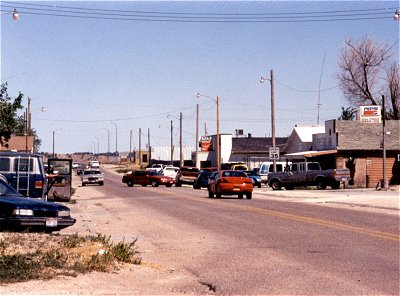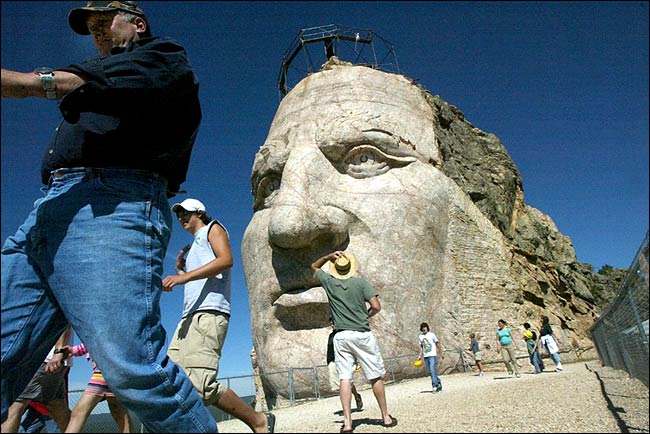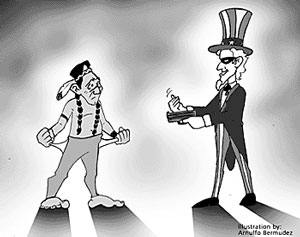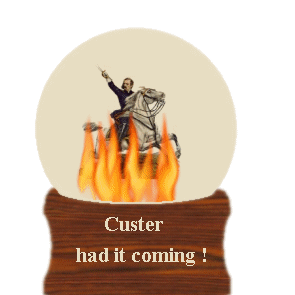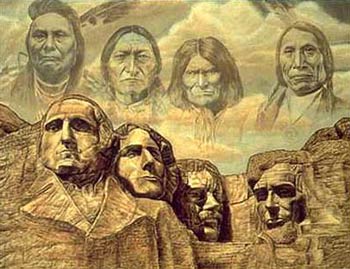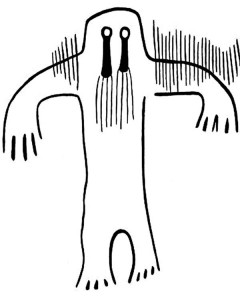Economic Development Revs Up on Pine Ridge ReservationBy Stephanie WoodardSupporting them is an expanding infrastructure, with public transit throughout the 2 million-plus-acre reservation, good cell-phone coverage in most areas and wireless Internet widely available. Approval of a federally backed credit union is imminent, said Whitney O’Rourke, Oglala, of Lakota Funds, a community development financial institution in Kyle, South Dakota in northern Pine Ridge. There is currently no bank on the reservation, and off-reservation banks make few loans there because much of the land that might act as collateral is held in trust by the federal government or is tribally owned. That will make a credit union the game-changer, easing access to cash and encouraging business formation and homeownership.
“The reservation has 40,000 residents ready, willing and able to participate in the regional economy,” said Mark St. Pierre, chief executive officer of Wounded Knee Community Development Corporation (CDC). Set in Pine Ridge’s central Manderson Valley, a bucolic sweep of hills bounded by pale cliffs, Wounded Knee’s CDC is one of several community groups and nonprofits with seed grants and creative ideas. They’re where the real economic action is, says St. Pierre, with plans ranging from small businesses to housing, a critical need on Pine Ridge. His CDC is looking for funding to build a destination resort on the 600 acres it owns in Manderson Valley and a factory that would make high-end caskets, then expand to other types of millwork.And:
Pine Ridge may be ready to participate in the regional economy, but is the region welcoming them? asked St. Pierre, of Wounded Knee CDC. Pine Ridge and other South Dakota reservations already contribute generously to the state’s economy—too generously some say, as money arriving in Native communities is typically spent immediately in nearby border towns, without changing hands and producing income in reservation businesses first. “Keeping money on the reservation and supporting our mom-and-pop businesses is the big issue,” said Emma Featherman-Sam, Oglala, coordinator of Oglala Sioux Transit.
Even worse, much of the spending goes to down-market, predatory vendors, according to O’Rourke. She described payday lending as a terrible problem, along with deed and title loans, through which cash-strapped tribal members put up home and car documents in return for short-term loans at sky-high interest rates, as much as 650 percent. Border town stores sell goods at inflated prices, knowing reservation residents may not have gas money to drive further to find bargains, and alcohol sales in retail stores and bars ringing Pine Ridge—just beyond the dry reservation’s jurisdiction—further empty tribal members’ wallets. “The border towns have a parasite–host relationship with the reservation,” said Tilsen.
Other restrictions on Pine Ridge’s economy are more subtle: When visitors arrive at the Rapid City airport, rental-car companies provide maps of western South Dakota showing a narrow slice of the state along the western border, guiding tourists to state and national parks and neatly eliminating all the reservations. The same map is available in shiny, laminated form at the Badlands National Park visitor centers, a federal operation, where you can get a map of the adjoining Pine Ridge Indian Reservation only if you know to ask for it.
Though cultural tourism is widely considered the wave of the future, browsing South Dakota’s tourism website reveals little about the state’s reservations and their attractions, including pow wows year-round. Entering “Native American” into the search box pulls up assistance for tour companies wanting to organize coach trips to reservations and directions to off-reservation Crazy Horse Memorial—ways for outsiders to look at Native Americans, but little support for Native people’s own enterprises.
Simply finding the reservation can be more difficult than it needs to be; those heading from Rapid City to Pine Ridge will discover that major turnoffs are not well marked. “We’re working on that,” said Featherman-Sam. “We’re talking to the state about installing more signs.”Comment: I was there the day before this article was published. I can verify that the tourist map for western South Dakota doesn't cover the reservations, and the highway signs aren't great.
We lunched at the single Subway's in Pine Ridge--the one featured in
20/20's Children of the Plains. I asked Jayson Brave Heart, one of our Lakota guides, about businesses on the rez. He said there was a Taco John's, and added that a McDonald's or a laundromat would do incredibly well.
Why doesn't someone start such businesses? Brave Heart gave two main reasons. One, as the article notes, it's hard to get a loan for start-up capital. Two, the town lacks needed infrastructure such as water and electricity. In non-Native locales the government installs these things automatically, but in Pine Ridge they have to go through the BIA's bureaucracy.
So how did the Subway's get started? Brave Heart said the founder was a former BIA superintendent or some similar official. He was able to cut through the red tape, get a loan, and buy a franchise. Not because he was a better businessman, but because he had the connections and clout to get his way.
More attractions neededAs an outsider, even I could see some of the business problems. Pine Ridge is a couple of hours away from the state's biggest towns. There are few attractions between it and Rapid City, where people go to see Mt. Rushmore. When you drive to Pine Ridge, the highway is almost empty. There isn't enough traffic to support a major casino.
I can imagine things that would attract tourists. Work with the National Park Service to offer genuine Lakota tours of the Badlands. Arrange fossil- and rock-hunting expeditions with Lakota guides. Museums are interesting--to me, at least--so build a Museum of Lakota History and Culture. Buffalo are an integral part of the culture, so establish a buffalo ranch where people can see the animals up close. Show off places like the Red Cloud Indian School, which we saw, and the Tanka Bar manufacturing plant, which we didn't.
Wounded Knee is another site the Lakota could develop, but there you want to be careful. The site is small and tranquil, and the typical visitors center with gift shop and parking lot would overwhelm it. Perhaps the Lakota could raise some tourist attractions a mile or so away, out of sight of the site.
Once you have a few marketable attractions, the state will start to include the rez on its maps and signs. People will start visiting and looking for more things to do. This will create a feedback loop, with tourist spending generating jobs and businesses that in turn attract more spending.
Note: I'm sure the Lakota have thought of these things before. I'm not claiming to have any great ideas or insight here. I'm just sharing my naive perspective with readers who may be even more naive than I am.
Rob wrong about rez?Incidentally, after visiting the rez I tweeted:
To me, Pine Ridge looked like any small rural town. I didn't see the abject poverty seen by the likes of Diane Sawyer and Nicholas Kristof.A fellow non-Native traveler challenged me on this, suggesting I was ignoring the poverty and pain behind the facade. He wondered who I was to judge the reservation after a half-day visit.
I'm someone who's read thousands of articles on hundreds of reservations for two decades, that's who. Which gives me an advantage over youngsters who were in grade school when I began. But I'll explain my comment to him and anyone else who didn't get it.
First, let's set the scene. When you drive through Pine Ridge, the first thing you notice is a lot of trailers and portable homes. They're evidence of poverty, of course, but the structures look reasonably well-maintained.
What you don't see is decaying hovels with peeling paint or yards full of junkers and other trash. You know, the kind of "lunar" landscapes you find in ravaged inner cities and outer towns alike. Because of all the negative press, that's kind of what I was expecting.
Nor did I see crowds of idle Indians hanging out because they're unemployed. None of the drunks, whores, or hoodlums you might find in a typical issue of the
SCALPED comic book. (There were a handful of apparent drunks in Whiteclay, but that's a different story.) The
holiday may have had something to do with it, but I'd expect
more loitering on a holiday, not less.
These things may exist somewhere on the rez, but I didn't see them. And we criss-crossed the area several times during our visit.
Things are bad, but...Here's the point. I absolutely am
not saying the poverty, crime, gangs, domestic violence, substance abuse, and suicide don't exist. When I think of small rural towns, on or off the rez, I suspect these things are going on.
What I'm saying is you can't drop in like Diane Sawyer, Nicholas Kristof, or me and get the whole picture at a glance. It's not as
obviously bleak as portrayed in
Children of the Plains or
Kristof's column. Or in SCALPED, which presents the same kind of
poverty porn.
I have no problem saying conditions on Pine Ridge are bad. But I side with the Native critics who claim things aren't as bad as they're portrayed by non-Native outsiders who look for the worst. We saw construction going on in town...a college about to graduate a class of students...and horse races where children rode proudly like their ancestors.
If I were going by the evidence of my eyes, I'd say the situation was inconclusive. I'd want more information before drawing conclusions. Unlike some observers, I wouldn't presume that a poverty-stricken reservation is mired in despair and hopelessness.
In short, any TV show, article, or comic book that doesn't capture the positive as well as the negative is a failure in my eyes. That's a point I have made and will continue to make until everyone gets it.
Any questions? For more on the subject, see
Rez Life Avoids Poverty Porn and
What Reservations Are Really Like.
Below: Whiteclay just south of the Pine Ridge border--perhaps the source of wholly negative reports.
